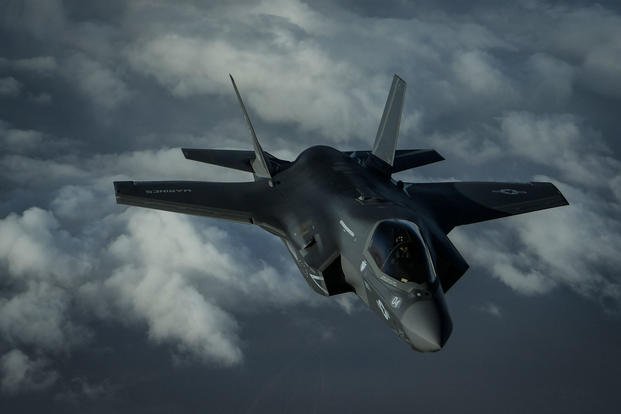The Pentagon has grounded all service variants of the F-35 Joint Strike Fighter weeks after an F-35B crashed outside Marine Corps Air Station Beaufort.
The Defense Department will inspect potentially faulty fuel tubes within the engine before aircraft are allowed to take to the skies again, the Joint Program Office said Thursday.
"The U.S. services and international partners have temporarily suspended F-35 flight operations while the enterprise conducts a fleet-wide inspection of a fuel tube within the engine on all F-35 aircraft," said Joe DellaVedova, spokesman for the F-35 Joint Program Office.
"If suspect fuel tubes are installed, the part will be removed and replaced. If known good fuel tubes are already installed, then those aircraft will be returned to flight status. Inspections are expected to be completed within the next 24 to 48 hours," he said in a statement.
F-35 manufacturer Lockheed Martin Corp. also issued a statement in connection with the grounding.
"We are actively partnering with the Pentagon’s F-35 Joint Program Office, our global customers and Pratt & Whitney to support the resolution of this issue and limit disruption to the fleet," company executives said in the statement.
Maintainers will inspect the fuel tube for quality assurance, an official close to the F-35 program told Military.com.
"This is engine-by-engine, aircraft-by-aircraft. [It is] not a grounding where all aircraft need to sit out to for a select period of time," the source, who declined to be publicly identified, said.
The official said aircraft across all services could be back in the air very shortly upon inspection.
This "is not expected to significantly impact production or delivery" to U.S. and international customers, the official said.
Aviation Week first reported Thursday that operations for the Marine Corps' F-35B variant would be paused for inspection. JPO later said the inspections would also apply to A and C variants.
The United Kingdom, which flies the B variant, had resumed flight operations on its aircraft carrier Queen Elizabeth following inspections Thursday, sources told Breaking Defense.
DellaVedova said the issue stems directly from the Sept. 28 crash.
Related content:
- Watchdog Slams F-35 Program for Taking Shortcuts That Could Harm Troops
- Marine Corps F-35B Crashes in South Carolina, Pilot Ejected Safely
- DoD Begins Accepting F-35 Fighters After Corrosion Issue
The aircraft, assigned to Marine Fighter Attack Training Squadron 501, marked the first crash for the Marine Corps' variant, which is designed to operate from ships with short takeoff and vertical landing capabilities.
The pilot ejected and was treated by local authorities. The cause of the crash is under investigation.
DellaVedova said the goal of the ongoing inspection is to prevent future mishaps.
"We will take every measure to ensure safe operations while we deliver, sustain and modernize the F-35 for the warfighter and our defense partners," he said.
On Wednesday, about two weeks after the F-35B crash in South Carolina, Marine Corps Commandant Gen. Robert Neller told reporters the readiness rates on the service's variant of the Joint Strike Fighter jet were "surprisingly good."
The service's F-35B has been operating in the Middle East during a deployment with the 13th Marine Expeditionary Unit aboard the amphibious assault ship Essex. In late September, the aircraft carried out its first combat mission when it dropped munitions on a Taliban target in Afghanistan.
Neller said the readiness of the aircraft on that deployment gets "better every day … To the point where I'm corresponding with the [commanding officer] out there, and I say, 'How are you doing it?' "
The F-35Bs the squadron is flying are some of the newer versions, he added. "So we'll see as these airplanes continue to get fielded if they're able to maintain that level of readiness."
The Navy and Air Force have also reported F-35 mishaps in recent weeks.
Last month, a Navy F-35C assigned to the California-based Strike Fighter Squadron 125 made an unexpected landing at Fresno Yosemite International Airport after an indicator light lit up. No injuries were reported.
In August, an F-35 with that same squadron was damaged during an aerial refueling exercise along with an F/A-18F Super Hornet.
That same day, two Air Force F-35As experienced mishaps in Florida. One stealth fighter suffered a nose-gear malfunction and another struck a bird.
Earlier this year, the Pentagon temporarily suspended acceptance of new Joint Strike Fighters over corrosion issues. Corrosion occurred in fastener "holes that were drilled and not corrected or properly treated found during an inspection at Hill Air Force Base, [Utah]," Lt. Gen. Arnold Bunch, the Air Force's military deputy for the Office of the Assistant Secretary for Acquisition at the Pentagon, said in March.
Officials roughly two months later said the JPO had again begun accepting the stealth aircraft after suspending deliveries from Lockheed Martin over a disagreement over who would pay to correct corrosion issues due to the production error.
In September 2016, the Air Force ordered a temporary stand-down of 13 out of 104 F-35s in the fleet, "due to the discovery of peeling and crumbling insulation in avionics cooling lines inside the fuel tanks," Air Force spokeswoman Ann Stefanek said at the time.
That same month, pooled fuel in the tailpipe of an F-35 resulted in a fire at Mountain Home Air Force Base, Idaho.
Officials with the Air Force or Naval Air Forces did not immediately respond to questions about when the A and C variants would begin flying again.
-- Oriana Pawlyk can be reached at oriana.pawlyk@military.com. Follow her on Twitter at @Oriana0214.
-- Gina Harkins can be reached at gina.harkins@military.com. Follow her on Twitter at @ginaaharkins.














